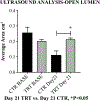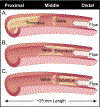A new way to treat proximal deep venous thrombosis using E-selectin inhibition
- PMID: 32067728
- PMCID: PMC9006622
- DOI: 10.1016/j.jvsv.2019.08.016
A new way to treat proximal deep venous thrombosis using E-selectin inhibition
Abstract
Objective: There is an inter-relationship between thrombosis and inflammation. Previously, we have shown the importance of P-selectin in thrombogenesis and thrombus resolution in many preclinical animal models. The role of E-selectin has been explored in rodent models and in a small pilot study of clinical calf vein deep venous thrombosis. The purpose of this study was to determine the role of E-selectin in thrombosis in a primate model of proximal iliac vein thrombosis, a model close to the human condition.
Methods: Iliac vein thrombosis was induced with a well-characterized primate model. Through a transplant incision, the hypogastric vein and iliac vein branches were ligated. Thrombus was induced by balloon occlusion of the proximal and distal iliac vein for 6 hours. The balloons were then deflated, and the primates recovered. Starting on postocclusion day 2, animals were treated with the E-selectin inhibitor GMI-1271, 25 mg/kg subcutaneously, once daily until day 21 (n = 4). Nontreated control animals received no treatment (n = 5). All animals were evaluated by magnetic resonance venography (MRV); evaluation of vessel area by ultrasound, protein analysis, hematology (complete blood count), and coagulation tests (bleeding time, prothrombin time, activated partial thromboplastin time, fibrinogen, and thromboelastography) were performed at baseline, day 2, day 7, day 14, and day 21 with euthanasia. In addition, platelet function and CD44 expression on leukocytes were determined.
Results: E-selectin inhibition by GMI-1271 significantly increased vein recanalization by MRV vs control animals on day 14 (P < .05) and day 21 (P < .0001). GMI-1271 significantly decreased vein wall inflammation by MRV with gadolinium vein wall enhancement vs control also on day 14 (P < .0001) and day 21 (P < .0001). The thromboelastographic measure of clot strength (maximum amplitude) showed significant decreases in animals treated with GMI-1271 vs controls at day 2 (P < .05) and day 7 (P < .05). Animals treated with GMI-1271 had significant vessel area increase by day 21 vs controls (P < .05) by ultrasound. Vein wall intimal thickening (P < .001) and intimal fibrosis (P < .05) scores were significantly decreased in GMI-1271-treated animals vs controls. Importantly, no significant differences in hematology or coagulation test results were noted between all groups, suggesting that E-selectin inhibition carries no bleeding potential. GMI-1271 did not affect platelet function or aggregation or CD44 expression on leukocytes. In addition, no episodes of bleeding were noted in either group.
Conclusions: This study suggests that E-selectin modulates venous thrombus progression and that its inhibition will increase thrombus recanalization and decrease vein wall inflammation, without affecting coagulation. The use of an E-selectin inhibitor such as GMI-1271 could potentially change how we treat deep venous thrombosis.
Keywords: Animal models; Coagulation; E-selectin inhibition; Glycomimetic; Inflammation; Nonhuman primate; Venous thrombosis.
Copyright © 2019 Society for Vascular Surgery. Published by Elsevier Inc. All rights reserved.
Figures






Comment in
-
Understanding venous thrombosis pathways to effect pharmacologic treatment and resolution of venous thrombosis without increasing bleeding risk.J Vasc Surg Venous Lymphat Disord. 2020 Mar;8(2):279. doi: 10.1016/j.jvsv.2019.09.004. J Vasc Surg Venous Lymphat Disord. 2020. PMID: 32067729 No abstract available.
References
-
- Anderson I, Cifu AS. Management of Bleeding in Patients Taking Oral Anticoagulants. JAMA. 2018;319(19):2032–3. - PubMed
-
- Chai-Adisaksopha C, Hillis C, Isayama T, Lim W, Iorio A, Crowther M. Mortality outcomes in patients receiving direct oral anticoagulants: a systematic review and meta-analysis of randomized controlled trials. J Thromb Haemost. 2015;13(11):2012–20. - PubMed
-
- Myers D Jr., Farris D, Hawley A, Wrobleski S, Chapman A, Stoolman L, et al. Selectins influence thrombosis in a mouse model of experimental deep venous thrombosis. J Surg Res. 2002;108(2):212–21. - PubMed
-
- Sullivan VV, Hawley AE, Farris DM, Knipp BS, Varga AJ, Wrobleski SK, et al. Decrease in fibrin content of venous thrombi in selectin-deficient mice. J Surg Res. 2003;109(1):1–7. - PubMed
-
- Jilma B, Marsik C, Kovar F, Wagner OF, Jilma-Stohlawetz P, Endler G. The single nucleotide polymorphism Ser128Arg in the E-selectin gene is associated with enhanced coagulation during human endotoxemia. Blood. 2005;105(6):2380–3. - PubMed
Publication types
MeSH terms
Substances
Grants and funding
LinkOut - more resources
Full Text Sources
Other Literature Sources
Medical
Miscellaneous

